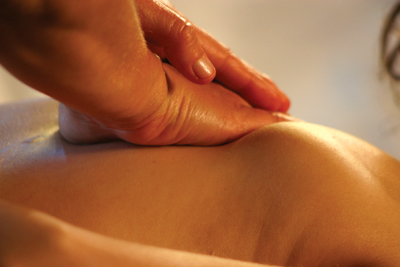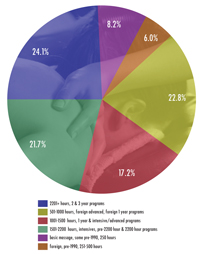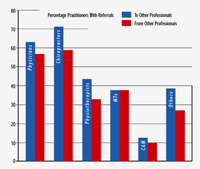
Features
Finance
Management
Highlights From the 2004 AMTWP Massage Therapist Survey
In 2003, the AMTWP Standards Review Task Force (SRTF) included in its recommendations “That, in formulating its policy on Uniform Standards and Regulation, the AMTWP considers … conducting a formal survey of the membership for additional information.”
September 29, 2009 By Massage Therapy Magazine
In 2003, the AMTWP Standards Review Task Force (SRTF) included in its recommendations “That, in formulating its policy on Uniform Standards and Regulation, the AMTWP considers … conducting a formal survey of the membership for additional information.” While some research and limited surveys had been done, the SRTF had found little data that looked at all aspects of the massage therapy industry across Canada as the public was using it, or that could provide conclusive support for answers to massage therapy practitioner questions or concerns.
 The survey was mailed on June 1st, 2004 to 1,793 massage therapist members. With no follow-up, 707 surveys were received by the deadline date. The survey is confirmed by the University of Alberta Population Research Laboratory as 95% accurate with a margin of error of 3.3%. Results were compared to other survey results, and to AMTWP membership database information – no significant differences were found. As this survey was of massage therapy practitioners, results can only be applied to that population, not to other AMTWP members.
The survey was mailed on June 1st, 2004 to 1,793 massage therapist members. With no follow-up, 707 surveys were received by the deadline date. The survey is confirmed by the University of Alberta Population Research Laboratory as 95% accurate with a margin of error of 3.3%. Results were compared to other survey results, and to AMTWP membership database information – no significant differences were found. As this survey was of massage therapy practitioners, results can only be applied to that population, not to other AMTWP members.
- 85% of the practitioners across Canada are female, 15% male (slightly higher male percentage in regulated population).
- 62% are in the 25 to 44 years of age bracket, with 23% over this age bracket and 15% under.
- Approximately 50% live in rural settings (population less than 100,000) and 50% in urban regions (>= 100,000).
- For 42%, massage therapy is a first career; this number is increasing.
- Practice longevity: the number of practitioners in practice is fairly consistent over time, with around 10% of the population being in practice for each of the first five years, and then slowly decreasing.
- 16% who responded resided in regulated provinces; 8% were Registered Massage Therapists, 8% practiced general intent massage1 at AMTWP massage competency standards. Note: of the estimated 20,400 massage practitioners in Canada (based on published 2004 numbers of the Canadian Massage Therapy Alliance members, Spa Canada, independent massage groups, regulatory colleges, and the AMTWP), about 36% are registrants of regulatory colleges.
-

When looking at the total massage therapy services provided, based on practitioners’ estimates of the services used in their practice, 34.3% are for general effect massage (not directed towards altering pathological processes in direct and specific ways1), 36.2% are for basic remedial massage (pathologies have local, defined, and clear presentation), and 29.5% are for advanced remedial massage (pathologies encompass multiple or diffuse areas, have ambiguous or complex presentation, and require refined judgment skills). 13% of practitioners only provide one type (5%, 2%, and 6% respectively), the rest providing a combination of two or more types of service.
- Practitioners with 500 hours or less of training were more likely to emphasize general massage services within their practice, while members with greater than 1500 hours training were more likely to emphasize remedial or advanced remedial services within their practice.
- 23.3% use trigger point therapy, 20.9% provide sports massage services, 19.8% use myofascial release, 15.6% provide maternal massage, 9.3% provide aromatherapy, and 9.3% provide spa services (body wraps, glows, etc).
- 16.1% provide reflexology, 15.3% cranial-sacral therapy, 14% chair massage, 11.9% Reiki (and 12.6% other types of energy work). Many other modalities were represented, but were practiced by less than 10% of massage therapists.
- Most practitioners are self-employed. Many have more than one place of practice. If the practitioners work with other health care professionals, though many were identified, those professionals were most likely other massage practitioners, chiropractors, or physiotherapists. The amount of training did not significantly affect the work place, though with over 500 hours of training, a practitioner was more likely (increase of 25%) to at least occasionally work with other health care professionals, and with over 2000 hours of training a practitioner was slightly less likely (13% decrease) to work at home. These results did not significantly vary between regulated and non-regulated environments.
- • practitioners believe that use of massage therapy is somewhat limited by the cost of services and insurance coverage, and suspect that about 56% of all massage therapy services provided are paid for through insurance plans. About 26% of massage practitioners direct bill insurance companies.
- 29% earned less than $10,000, 37% earned $10,000 to $25,000, and 22% earned $25,000 to $35,000 range. Only 12% earned more than $35,000.
- Regulation did not affect total income. To earn more than $25,000, a practitioner was most likely either working 20 or more hours per week, had more than 500 hours of initial massage therapy training, or worked in an urban setting. For those earning $25,000 or less, there was no urban-rural difference. Only 57% of practitioners rely solely on massage therapy for income.
- 70.9% considered working on clients for 21 or more hours as full-time work. Only 39% are working more than 20 hours (hands-on clinical application) per week. In their own opinion, 75% work almost or about the right number of hours, while 8% actually work more hours than desired.
- 31% of practitioners spend fewer than 2 hours per week on non-client work, 40% from 2 to 5 hours, and 29% spend more than 5 hours work per week.
- About half of the clients who visit massage practitioners are new clients, or visit less than once a month. The other half consists of clients that are seen more than once a month. Most practitioners see less than 100 clients per month.
 Considering this was the first survey looking at all massage practitioners providing massage therapy services, it set a good and broad-ranging foundation, though few trends could be discerned.
Considering this was the first survey looking at all massage practitioners providing massage therapy services, it set a good and broad-ranging foundation, though few trends could be discerned.
Certainly, as training programs advance, the training hours of massage therapists will continue to shift to
higher numbers while increasing knowledge about massage therapy and an increase in Spa services use will change other results over time. Future surveys will aim for higher response rates, and to even more closely mirror the massage therapist population across Canada. They will provide solid information on trend developments.
REFERENCES:
- College of Massage Therapists of British Columbia. Further Commentary on the Risk of Harm Associated with the Practice of Massage Therapy. A Supplementary Response to the Health Professions Council’s February 1999 Preliminary Report on the Massage Therapists Scope of Practice. July 6, 2000
Print this page